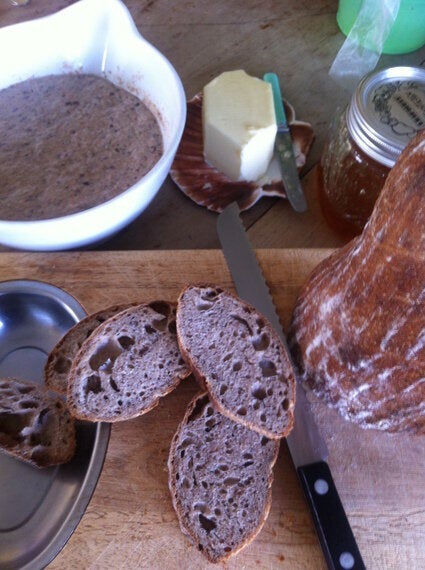
Hotchpotch Seaweed Sourdough
Porphyra spp. or laver is a red seaweed. Although, when you spy laver on rocks, it may look khaki green or even black. Seaweed is like this. Laver grows in the intertidal zone and on a breezy day, it will have stuck to the rock almost as firmly as it 'rock' neighbour, the limpet. You'll have to be eagle eyed to see it, but once you get your eye in you'll see it everywhere. It looks rather like sprawling pieces of refuse sack, tightly attached to the rock's surface.
It's similar to nori, which is made from the red algae Porphyra yezoensis and P. tenera. This has been cultivated in Tokyo bay since the 17th Century. The original nori was in paste form i.e. it was eaten wet, until the nori sheet was invented in Asakusa Edo (contemporary Tokyo). The technique for making nori drew upon traditional Japanese shredding and rack drying, papermaking skills. You can attend a free, nori - making workshops at the Omori Nori Museum in Tokyo. It's an educational facility, which highlights the tradition and history of nori in Tokyo. During a workshop, the nori is finely chopped (a grinder will help the home cook) and mixed with water to make a sloppy mash. A measure is then poured into a mould held over a woven, slatted mat. When the water has drained away, the mould is removed to leave a thin layer of chopped seaweed on the mat. This is then hung out on an easel in the sun to dry.
The Japanese love affair with nori is well known, if only through sushi but the Japanese affection for the British phycologist, Dr Kathleen Mary Drew-Baker (1901-57) is less widely recognised. In Japan, Kathleen Drew is known as Mother of the Sea. In 1949, she published a very brief paper in the journal Nature about the life history of Porphyra umbilicalis. It was described as 100 lines that should change the world because Kathleen Drew identified the missing link in the life cycle of porphyra. Prior to Drew's discovery porphyra life stages were thought to be two different species. Kathleen Drew's research changed the way that nori was cultivated and resulted in a guaranteed harvest. Previously the nori harvest varied and as a consequence, the seaweed was known as Gamblers' Grass. Grateful nori framers contributed posthumously to a statue in Kathleen Drew's honour, and each year on April 14th (Drew's birthday) in Sumiyoshi Shrine Park, nori farmers celebrate the Drew Festival.
British laver isn't the same species as Japanese nori but it is delicious. To call laver nori would be like calling British sparkling wine, Champagne. The Welsh are famous for laverbread, which I make and freeze. Laverbread adds texture and colour to dumplings on a cold autumnal day. Dried laver is a useful store cupboard sprinkler and if you are landlocked it is available in stores and on line too (from the Pembokeshire Beach Food Company.) I'm feeding my seaweed sourdough starter with dried laver at the moment. It's called Hotchpotch because it has been fed so many different species of seaweed. I'm fickle my favourite species of seaweed changes weekly but Hotchpotch continues to thrive.
This recipe is taken from Seaweed in the Kitchen.
Dumplings are comfort food at its best. This recipe can be adapted to use any finely ground dried seaweed by simply replacing the laver with extra water. Cooked laver may not look very appetising but the resulting dumplings are surprisingly colourful and packed with flavour. Add laver dumplings to a hearty stew and carbohydrates will take on a whole new dimension. A tablespoon of carrageen gel will enhance and give sheen to any stew or casserole.
Makes 6-8 dumplings (depending on size)
Marine algae: 2 tbsps of prepared laver (cooked)
Additional ingredients;
125g S.R. flour
50g suet
2 tbsps prepared laver (well chopped)
Approximately tbsp water
Put the dry ingredients into a bowl and mix in the cooked laver. Add enough water to work to a firm dough. Divide the laver dough into six and roll into balls. Add the dumplings for the last 25 - 30 minutes of a stew cooking time.